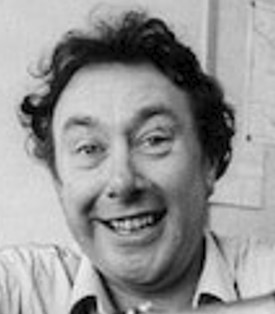
Obituary
Michael Green, humorist, was born on January 2, 1927. He died of a heart attack on February 25, 2018, aged 91.
Michael Green, born 2 January 1927 in Leicester, England, died 25 February 2018, was a journalist and author of humorous books. He is best known for The Art of Coarse Rugby, The Art of Coarse Acting and other books with similar titles. Some of the content in The Art of Coarse Rugby is based upon his experiences as a member and player of Ealing Rugby Club and other clubs.
Valedictory

![]() We have just learnt of the death of author & journalist Mike Green. Mike Green played for the Club in the early 1950s & was elected a V.P. Mike was well known in rugby circles for his humorous best-selling books “The Art of Coarse Rugby” & “Even Coarser Rugby” as well as several other humorous sporting books. Many of the characters, incidents & venues of these books could be identified from Mike’s experiences playing for our Extra B sides!
We have just learnt of the death of author & journalist Mike Green. Mike Green played for the Club in the early 1950s & was elected a V.P. Mike was well known in rugby circles for his humorous best-selling books “The Art of Coarse Rugby” & “Even Coarser Rugby” as well as several other humorous sporting books. Many of the characters, incidents & venues of these books could be identified from Mike’s experiences playing for our Extra B sides!
I knew Mike from when I was Social Secretary & invited him to dinners which he sometimes attended, He also was very instrumental in getting German TV to film an episode about the Club. They had been filming at the Questors Theatre where Mike was involved & when asked if there was another interesting venue close by he suggested Ealing Rugby Club & this was duly arranged.
It meant quite a lot of work as we had to change the day of training at short notice to comply with their schedules (no e-mails in those days & many phone calls made!). They also filmed all the 1stxv match which I can’t remember who we played but know we won in a wet a windy conditions. In the evening I had arranged a Jazz Night with a very good band & Horsenden Hill really jumped that night. The entertainment was greatly enjoyed by the film crew even though the band would not let them record the music due to contracts/ copyrights etc.
The Director of the German film crew also wanted to interview several club officials & stated he would ask a question & wanted a spontaneous reply so would not divulge the questions. He spoke to Bob Sowerby, President, myself & several others who all stated the ethos of rugby & positions for all shapes & sizes depending on teams etc & camaraderie, particularly at Ealing. He then got to Dave Phillips who was a good “1st xv backrow but had some eccentric habits”. The question put to Dave was “what do like about Ealing Rugby Club?” to which Dave replied with a straight face but tongue in cheek “The Money”. It should be remembered that at this time the RFU insisted all rugby was amateur & there were severe consequences for clubs who did not comply - Ealing did comply.
This caused some of the club officials to get very hot under the collar to say the least.
I know the Club was supposed to get a copy of the film, but I never saw it & don’t know of anyone who did, although I was told that it was shown on German TV.
Mike Williams

![]() Farewell to Michael Green, the writer who revelled in rugby’s camaraderie. Green’s contribution to game’s literature still resonates.
Farewell to Michael Green, the writer who revelled in rugby’s camaraderie. Green’s contribution to game’s literature still resonates.
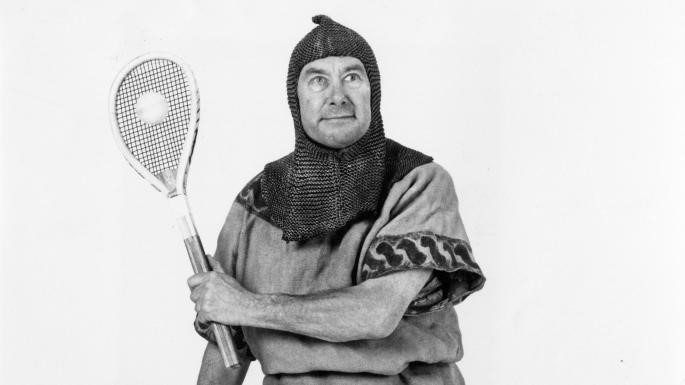
It was a tiny leviathan, a pocket revolution. It ran to less than 35,000 words, the author was paid 75 guineas and these days, it can read horribly out of date. And why would it not? It first appeared 57 years ago. But it changed rugby, it remains the most important book ever written on the sport and it still trickles over the counter after 23 editions. It has sold more than 250,000.
Michael Green - author of the wonderful Art of Coarse Rugby - was a journalist, author, actor and humourist - a marvellous friend, and a colleague on this newspaper. He died last week at 91, played tennis into his late 80s, and was married in his ninth decade. He was delightful, the sweetest man I ever met.
Coarse Rugby was based on rugby as he had played it and loved it in the post-war years in Leicester and then for Ealing in west London. He played in the lower classes (of ability) and claimed that the common denominator of his coarse rugby peers was that they were all cowards. He describes an era when the concept of 15 players on each side was simply a basis for negotiation, of awful referees, of muddy pitches and communal bath tubs containing an inch or two of cold brown water if his game finished after the others.
He invented a whole load of characters based on his experience, but we know them all already; and invented two made-up but familiar teams, Bagford Vipers and Old Rottinghamians. We knew them too, as if they had always existed.
Michael embellished gloriously, usually so that stories would rebound better on himself. But there probably really was a club which had an old bus as changing rooms, and which had to be pushed up and down every Saturday because there was no planning permission for a permanent structure; there probably was a time when a crossbar fell down and laid out five defenders after a conversion attempt bounced back off it - only for the referee to allow the kick.
There probably was a time when four Coarse teams turned up, all short of players, and so they played one 21-a-side game between them. And there were people who would smoke and drink at half-time and even during games, there was a time when vast numbers went out to play rugby for the sheer fun of it, unembarrassed by lack of technical merit or, largely, by defeat.
It may seem hopelessly dated in rugby’s nuclear age but its impact was thunderous. So many modern forms of media had yet to be invented, there was just hard-copy newspapers, no sports channels. There were no leagues in rugby, so that while people were aware that they loved playing the game, it was always in their own little arena, with no news from outside. There was no urgency at the clubs because there was no promotion and relegation, and there were few gleaming facilities because they were not expected.
The Art of Coarse Rugby suddenly made tens of thousands of people realise that they were full-time members of a club and a brotherhood they had never consciously joined. They found that a vast freemasonry of people in the home countries and especially in England and Wales had a sporting philosophy just like theirs; they wanted to play the game and to drink and to take part in all its glorious camaraderie and warmth.
Decades ago, I recall school friends asking if I had heard about the book, wondering where we could borrow a copy. We took our rugby seriously but we recognised the Green world where, sometimes, there were no touch-judges and sometimes, not even any touchlines.
Michael kept updating his introduction as different editions were produced and as the game boomed and became more serious. In the end, he decided to give up apologising for the antiquities and the old-fashioned ways and quite correctly, let them stand on their own merits.
Michael covered international rugby for this paper and wrote his weekly Rugby Roundup, inserting into a newsy column his own self and his love of the other ranks. He adored clubs such as Streatham/Croydon, Esher and Wasps, who all at one time ran 14 men’s teams every Saturday. He was on guard to spot any dangers to that camaraderie of all ages and abilities.
When covering the gleaming top ranks he could be waspish. Once, reporting on a perfectly good Scotland-Wales game at Cardiff, his intro read: “To the all-pervading odour of vinegar and fried chips which forms the main atmosphere at Cardiff on match days….” I don’t think that’s quite the image that marketeers wish to portray at the Principality stadium these days.
But he was never in any way a polemicist. He was never happier than when he was encouraging laughter at himself and the stories came in battalions. He was a reporter in the days before mobile phones and so reporters could not contact their office if on a train. Once, on the two-hour trip between Leicester and St Pancras after covering the Tigers, Michael realised that he had made an error and got the name one of the Leicester try-scorers wrong. He told the story later that he was reduced to throwing out little notes as he passed small stations, asking whoever found the note to ring the Sunday Times to tell them that Smith, not Jones, had been the Leicester scorer. No one did.
Not all the reminiscences came from sport. When he was stationed in Italy in a tank regiment after the end of the war, he was guarding 45 Italian prisoners. They all escaped, but all returned after a night at a nearby pub. His most glorious literary efforts were two volumes of autobiography - “The boy who shot down an Airship”, and “Nobody hurt in small Earthquake”. They were both about his life post-war in the Midlands, his career as an actor, which rivalled his passion for rugby. He told of attempting to exit a scene through a door off the stage which was in fact a door frame painted onto the scenery.
His books are marvellous for any journalist who wishes to know where we all came from - he began on local papers in the Midlands, and you are reminded yet again what a magnificent service those papers provided and - in some places - still provide, how absolutely indispensable they were. He continues about his life on Fleet Street, in an era of hot metal with the spike and the stone. The books are magnificent, funny, beautifully observed and profoundly moving.
It is hard to say if one anecdote in the book gave a clue to Green’s character or not. One day after covering Northampton he had a few drinks and drove to one of the many acting groups he attended. He had a few more drinks and then offered to drive the company’s leading actor, Colin Wisdom, to the station. He woke up in hospital, having lost control. Wisdom, who had a young son with Gay, his wife, died in the crash. Michael was fined £15 for careless driving and as he wrote years afterwards: “I found it difficult to forgive myself and I still do. Something which can make life difficult for a professional humorous writer.
The third and final volume of his autobiography was eagerly awaited but never arrived. Publishing houses changed and no one was willing to act on the contract he had already signed. He recently told the Rugby Paper: “Modern rugby has developed to the point where if it goes down any more avenues it will cease to be rugby and will become another game. I still just about recognise rugby as the game I played, even if backs now pile in like forwards and forwards run and handle like backs, and everybody spreads across the field in that strange way.”
“But we are getting very close to American Football with all the delays, the television match officials, the use of technology, huge numbers of replacements seemingly coming and going at will. Top-level rugby is in danger of becoming divorced from the game everybody else plays at school and at the weekends, and that is very dangerous territory indeed. Rugby, of all games, needs to keep that connection.”
Dated? More like bang up to date. It may be down to Michael that some of us still believe the most important thing about rugby to be not internationals, but boys and girls and men and women out there every week, any weather, any standard. I don’t think there is anywhere where they have to push the button these days, but it is important that we respect the memory of all those who did. Thank you for everything, Michael.
Stephen Jones, March 4 2018, The Sunday Times

![]() Michael Green, who has died aged 91, was an eccentric newspaper man and the author of The Art of Coarse … books, a series that with breezy wit covered pastimes such as rugby, acting
Michael Green, who has died aged 91, was an eccentric newspaper man and the author of The Art of Coarse … books, a series that with breezy wit covered pastimes such as rugby, acting
and sex.
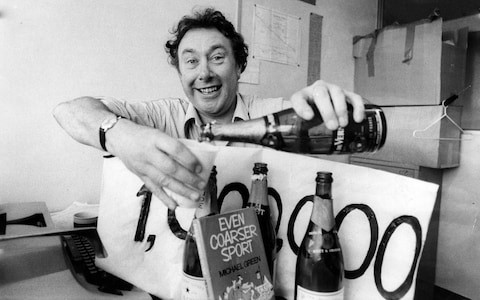
CREDIT: MICHAEL WARD/TIMES NEWSPAPERS
They started after he wrote a piece for The Observer about his nonchalant approach to rugby playing: “A publisher phoned me up the next week and offered me a few quid to try making a book out of the idea,” he recalled.
It led to “The Art of Coarse Rugby (1960)”, which he described as “a hack job for 75 guineas to pay a few bills” but which became a bestseller and was praised by E W Swanton for its “hilarious caricatures” of rugby types. Three years later came “Even Coarser Rugby”, the books turning Green into a folk hero to rugby fans.
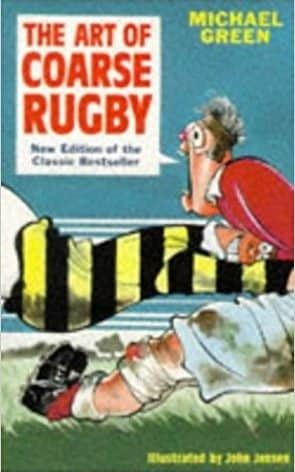
The “coarse” approach to a subject, he explained, was the way something happens in real life as opposed to the theoretical way of doing it - “nothing to do with crudeness but with stark, unrefined reality”. It was a quintessentially British attitude that involved “losing and being rubbish and incompetent, while aspiring to so much more”.
“The Art of Coarse Acting (1964)”, with drawings by John Jensen, was one of his most enduring titles, and it went on to inform a series of plays. His definition of a “coarse actor” was “one who could remember the lines but not the order in which they come” and a feature common to all coarse actors was, he said, “that they think every performance is a success”.
“The Art of Coarse Sex (1980)”, subtitled “Or how to love better and die with a beautiful smile on your face”, spoofed the sex-advice manuals that were flooding the market. It was packed with ribald tales such as that of a friend’s tent which collapsed while its occupants were in flagrante, leaving the friend commenting: “It was easier to re-erect the tent than me”, and included chapter headings such as “How to attract women” and “Starting an affair”.
Michael Frederick Green was born in Leicester on January 2 1927 and educated at Wyggeston Grammar School, where he enjoyed amateur dramatics and even-more amateurish rugby. According to one profile he played for “more clubs than Jack Nicklaus”, including Leicester LTC, Leicester Harlequins, and Leicester Thursday.
It was in his match-playing days that his understanding of “coarse rugby” evolved. “Most of us were cowards,” he recalled. “In all honesty the first couple of pints after the game were usually to celebrate my survival.”
Meanwhile, Green had joined the Leicester Mercury as a messenger boy, but that came to an abrupt end after he boasted to a colleague that he knew how the huge printing presses in the basement worked.
Having brought them to life, an enormous reel of paper broke, spewed on to the machine room floor and continued doing so until he could locate a mains switch.
He resurfaced at the Northampton Chronicle and Echo, where he was assigned to cover the local rugby team, often travelling with the Saints. His first big interview with their captain took place during the post-match shower, with Green fully clothed.
On another occasion he was forced to eat dinner in a Liverpool hotel trouserless after the team had debagged him on the train journey; fortunately, his modesty was protected by a trench coat.
As an amateur thespian, Green developed a keen ear for the absurd, whether on-stage or off. He was always nervous about the actor’s traditional cri de guerre “break a leg”, having once done just that by falling off stage and being ferried to hospital dressed as an 18th-century pirate complete with eye patch and wooden leg.
His newspaper career took him to the Birmingham Gazette and then The Observer, where he later recalled asking the sports editor: “Why don’t you give some space to the real rugby, the sort played by ordinary blokes like me?”
The response came back: “Do a feature on it if you feel so strongly.” Later Green would write a rugby column for The Sunday Times.
He recalled his early experiences in “Don’t Print My Name Upside Down (1963)”, a sharply observed novel about life on a small-town paper.
There were more than a dozen Art of Coarse books, including titles dedicated to sailing (a coarse sailor was one who “in a crisis forgets nautical language and shouts, ‘For God’s sake turn left’ ”) as well as drinking, golf, moving house and office life. In the 1970s he took a degree at the Open University.
He also wrote two volumes of memoirs: “The Boy Who Shot Down an Airship (1988)” included reminiscences about his National Service just after the war, and “Nobody Hurt in Small Earthquake (1990)” covered his rake’s progress from provincial newspapers to Fleet Street.
Green’s other great literary creation was “Haggard’s Journal”, a very funny parody of a monstrous, drunken 18th-century squire’s journal, originally written as occasional contributions to the Telegraph’s Peter Simple column from 1962 and adapted as a book in 1975.
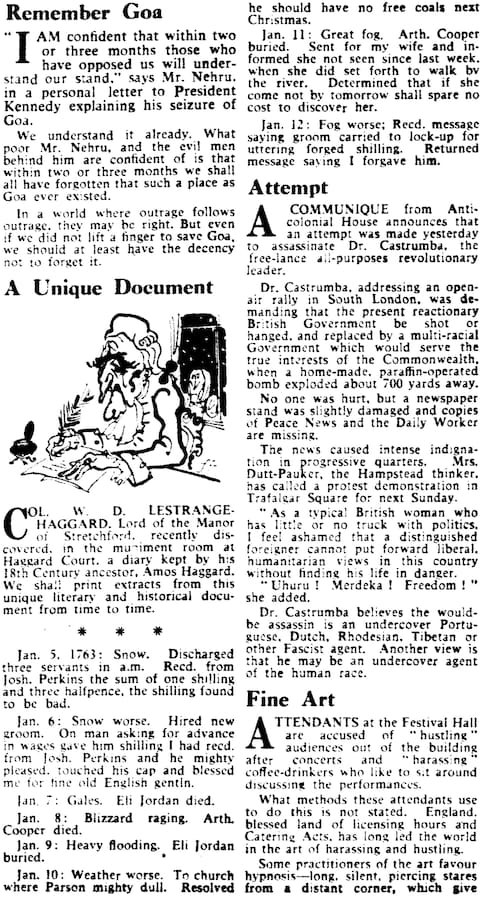
A representative entry read: “Dec 10 1777. Rain. Amos Bindweed d from Putrefaction of the Inward Parts. Jas. Soaper hanged for stealg a nail … Ate a pease puddg for dinner but it was bad, so gave what remained to my wife, and consumed two botts of Madeira to expunge the taste. ITEM: to purgatives, £0 0s ¼d.”
Extracts from the squire’s journal were read out on the BBC television sketch show Grubstreet (1972) and in 1990 it reappeared both as a regular column in The Daily Telegraph and as Haggard, a Yorkshire Television series with a script by Eric Chappell that ran for two seasons and starred Keith Barron.
For many years Green was a member of the Questors Theatre in Ealing, and in 1985 he wrote Coarse Carols for their choir.
Despite being fond of a drink, Green continued playing tennis into old age.He was a member of a club in Ealing that he described as “a very nice unstuffy place where, thankfully, they are inclined to throw you out if you turn up in whites”.
In 2004 Michael Green, who had once bolted from the register office on the day of his intended nuptials, married his partner of many years Christine Waite, a school music teacher. She survives him.
The Telegraph
